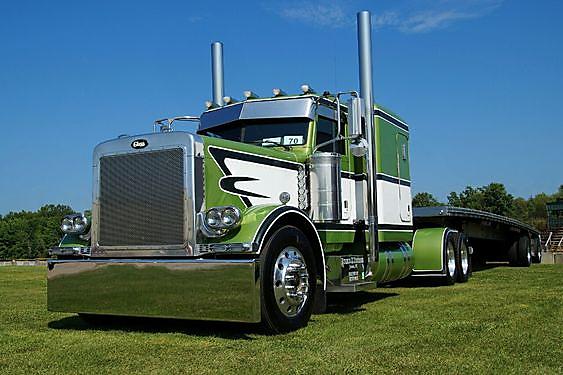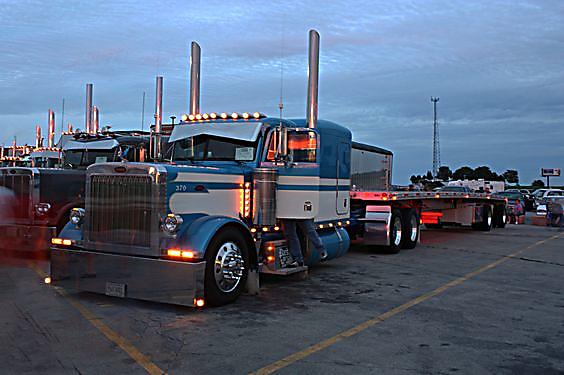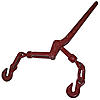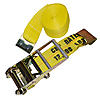
What is Flatbed Trucking?
Professional Flatbed Trucking is one of the most crucial ways of transporting cargo on our roadways every day and is often overlooked. Flatbed Trailers carry a wide range of different goods across the country such as Construction Materials, Metal, Raw Materials, and Oversized Cargo, and are a vital part of keeping the country moving every single day. Without Flatbed Truck Drivers it is estimated that the country would be at a standstill within a week as construction materials, household goods, and oversized heavy equipment could not be moved across the country.
Flatbed Trucking is a vital part of the professional trucking industry and it helps to keep America moving every single day. Flatbed Truckers often face a lot of added responsibility as some of the loads they are transporting can be much heavier, larger in size, and often require much more attention to detail when securing and shipping.
The Basic Requirements for Flatbed Trucking
The requirements for becoming a Flatbed Truck Driver begin with obtaining a Class A Commercial Drivers License also known as a CDL. Some of the qualifications for passing a CDL Class A Certification require a High School Diploma or GED certificate, the ability to problem-solve while on the road, and having an eye for attention to detail when it comes to safety guidelines. Although not exactly a requirement it will become much more difficult to become a flatbed truck driver with a bad driving record based on the last 5-7 years on average. Insurance is one of the main expenses for truck drivers and having a bad past driving record can greatly increase the cost of this expense.
Some of the additional skillsets may include being able to communicate with other drivers & scheduling deliveries, long hours on the road without facing fatigue, and being away from home for periods of time. Along with the physical requirements for this job, you must be someone who can sit for long periods of time, pass a vision test, or hearing test, are above the age of 21 years old, and be able to read road signs that are printed in English.
After receiving a Class A Commercial Drivers License you will need to find either a company to take a risk with you being a newer flatbed truck driver or have the means to purchase your own rig and flatbed trailer. Depending on if you work for yourself or a company you may need to pay for the costly insurance that professional truck drivers face or it may be provided for you through the company itself. Next comes the equipment needed to operate a flatbed trailer.
Some of the equipment you should expect to purchase include Ratchet Straps, Winch Straps, and a flatbed tarp system of choice to make sure that the loads you are transporting do not arrive damaged from snow, excessive heat, or rain. Cargo that arrives at the customer damaged could result in loss of business revenue or potentially ruined return business so it is important to take care of the cargo that is being transported while remaining safe.

What is the average pay for a Flatbed Truck Driver
The normal average pay for a CDL Class A Flatbed Truck Driver can expect to receive anywhere from $48,000 to upwards of $95,000 dollars or more per year with the average salary being $71,500. This can vary based on the state that you live in, the number of hours worked, on the road, or being home every night as well. One of the major benefits of being a professional truck driver is almost always new truck driving jobs posted every single day so finding one that fits you best may come sooner rather than later. We often get the questions of Is flatbed trucking worth it? and is flatbed trucking hard? and the answers for both of these can be quite difficult to answer so we have created a checklist of questions to ask yourself before becoming a Flatbed Truck Driver.
Some Questions you should consider before becoming a Flatbed Truck Driver
• Do you prefer being home every night or okay with being on the road?
• How many days are you okay with working per week during a busy season?
• Do you prefer to work for yourself or have a company arrange all of the shipments for you?
• Do you have a preference for driving in the Daylight vs driving at the Night?
• Are you looking for Day Drives or Week-Long Hauls with a Co-driver?
Depending on the answers to some of these questions it could quickly be used in order to determine if you would be a good fit as a professional truck driver with dry vans or a professional flatbed truck driver depending on which one is the best fit for your expectations in the professional trucking industry. One thing that is for certain is that there is also potential for accidents, road closures, or extreme weather to quickly change your weekly plans and you have to be understanding that you may often not meet your trucking deadline or plans outside of work occasionally. During the winter months or Hurricane season, there is always a chance that you may be stuck in a random city along the way waiting out the weather conditions as well.
If your answer to any of the questions above is not ideal for your work schedule it is extremely important to tell your recruiter ahead of time that may become a potential long-term issue. You should address your ideal expectations on pay, willingness to pick up extra hours as needed, and if you are not okay with being on the roads for longer periods of time throughout the year.

How to Start A Flatbed Trucking Business
When it comes to how to start a flatbed trucking business the first thing that you will need to consider is insurance, finding a flatbed trailer, picking a semi-truck, and picking up the correct equipment for all of your hauling needs.
Tips on finding the correct Semi Truck for Flatbed Trucking – One of the major things to consider of buying a used cheaper and yet more affordable rig vs a newer more expensive big rig is the cost of maintenance. If you are someone who goes on long hauls often the last thing you want to have to happen is a costly tow bill because of something mechanically broken inside of the engine bay of your big rig. If you are someone who is more mechanically inclined then perhaps an older semi-truck may be justified vs someone who is less mechanically inclined may opt to go toward the newer rig with less of a chance of something major breaking.
Another thing to consider is how readily available is the parts for your rig in the next 5, 10, or even 15 years down the road. If you are having trouble finding parts for repairs in the present it will often only get worse with time causing you to lose time on the road. In the professional trucking industry time is money so when the big rig is not moving you are not making money so this is something to greatly consider. Another major decision you will need to make is opting for a manual transmission that is easier to work on or an automatic transmission that is normally better on fuel with modern-day technology.
When it comes to finding a trailer generally most of the flatbed trailers are the same setup configurations. When equipping your rig with the proper equipment some of the things you will want to pick up before your first time being an owner-operator in the flatbed trucking industry are flatbed straps of choice. We often find that the vast majority of truck drivers prefer to use 4-inch winch straps and sometimes 3-inch flatbed tie-down straps based on personal preference.
Traditionally speaking more truck drivers use Flatbed Winch Straps that are designed to secure cargo through the use of the rub rails that are installed along the rails of the trailer. We do however know that certain cargo securement applications do require flatbed ratchet straps, transport chains & binder, and tarp systems in order to ensure the cargo arrives at its next destination without damage.
Popular Flatbed Trailer Equipment

The Trucking Industry Job Growth in 2020 and the Future
One of the biggest concerns for anyone who is looking to enter the professional trucking industry is job security. If you look at the numbers of new drivers at the current rate of growth according to the Bureau of Labor Statics the following: “The percentage of change or growth projected for Tractor-Trailer Drivers Along with Heavy Truck Operators as an occupation is expected to grow by 5%” This represents an increase of nearly 100,000 drivers between 2018-2028. Along with this static, the average age of a CDL Class A truck driver is around 49 years old. This means in the next 20 years there will be a demand for younger aged to middle age truck drivers in the future to keep the cargo in the united states moving.
Along with these great numbers and statistics for professional truck driver job security online shopping has seen increases of over 30% in the last year. This brings the normal average revenue per online shopper to $1,804 dollars per person with 68 males shopping online and 72% of females shopping online (source: Optinmonster). In 2021 with the rise of online shopping becoming increasingly popular and retail shopping still popular there will always be an abundance of packages that are needed to be shipped inside of the trucking industry.

Why Does Flatbed Trucking Pay More?
Flatbed trucking traditionally pays more than other types of professional trucking due to the different types of cargo they are transporting on the public roadways that require more attention, planning, rules, and securement knowledge. Some of the main differences in flatbed trucking are heavy machinery, oversized metal objects, and construction materials that are used to build anything from offices, houses, or manufacturing locations. This makes this job extremely important for someone to be reliable as tight deadlines in those industries could have costly delays for the many different teams involved in these projects.
A few other factors that are considered when driving flatbed trailers is the need for tarping down your load at every stop. This is much different than normal box trucks or dry vans as the walls of the exterior trailer protect the cargo from sunlight, strong winds, rain, and other weather throughout the year. When it comes to flatbed tarps every rig may require a different setup that may be unique to the application and requires expert knowledge at almost every stop to ensure that the cargo that arrives is not damaged when it reaches the next destination.

Frequently Asked Flatbed Trucking Questions
Is it hard to get into the professional flatbed trucking industry compared to other CDL jobs such as a dry van? – Although the requirements are mainly the same flatbeds are slightly harder to get into the industry as they are normally transporting much larger sized loads with much heavier load capacities than the dry van counterparts. This is normally why Flatbed Truck Drivers are paid slightly more in most states.
I’ve Previously Had An Accident on My Driving Record Can I Still Become A CDL Truck Driver? – Yes, although it will become much more difficult for someone who has not had any occurrences on their record. Some things to consider are the amount of time that has passed since the last accident, who was at fault in the accident, and your age is some things that can greatly impact your ability to open new doors in the trucking industry.
Are Flatbed Drivers Able to Drive Teams? – Although it is much rarer for Flatbed Truck Drivers to team drive as they are mainly picking up and unloading in the middle day there is a chance for longer mileage hauls. This can vary between team vs team and can greatly depend on the size of the load, weight of the load, and the experience as a team.











